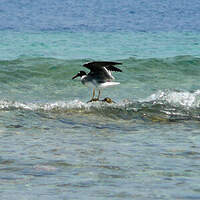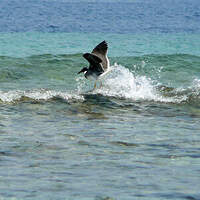White-eyed Gull
Ichthyaetus leucophthalmus - Goéland à iris blanc
Identification
The White-eyed Gull Ichthyaetus leucophthalmus is a small gull slightly larger than the Laughing Gull. Its slim silhouette, its long beak, its body held horizontally on rather long legs and its long wings pointing backwards, as well as its plumage, are all characteristic.
The adult in nuptial plumage has a total black hood that covers its whole head, extending down the neck and continuing into a black ruffle on the throat and front of the neck. Two white peri-ocular crescents encircle the eye both above and below, providing a strong contrast to the black hood. This gives the bird its French name, although its iris is actually a dark brown colour, with a red orbital circle. The upperparts (mantle, back and wing-coverts) are a quite dark grey. The tail and its coverts are white. The primaries are black, standing out in stark contrast against the white tail which they vastly overhang. The underside is white, with a pale grey wash on the lower throat and sides of the chest. The beak is strikingly long, being about the same length as the head, and a red-coral colour with a black tip. The legs are yellow. In winter, the bare parts are duller and the hood not so pure black.
In flight, the long wings appear dark above and below, showing a white trailing edge. From below, they stand out in bold contrast from the white body.
The juvenile plumage is very different to the adult as is typical in the family. The upperparts are entirely brown, lighter on the head and darker on the remiges. The white eye-crescents are present, but less obvious than in the adult. The underside is whitish. The tail is black, while the rump and uppertail-coverts are partly white. The beak is dark and the legs yellowish.Once they reach three years of age, adults will have acquired their full plumage, with immature birds having a plumage which is somewhere between the two. The White-eyed Gull can easily be confused with the Hemprich's Gull which shares its territory, especially in the immature plumage. The Hemprich's Gull is a slightly larger bird. When in adult plumage, the White-eyed Gull is a darker brown-grey on its upper half, with this shade stretching across its chest, but it does not possess a black hood. Its beak, which is thicker and shorter, is yellow with a red and black tip. The immature bird has beige-edged wing coverts, a two-tone beak (red-brown to blue-grey with a black tip) and grey feet.
Subspecific information monotypic species
Foreign names
- Goéland à iris blanc,
- Gaviota ojiblanca,
- gaivota-de-olho-branco,
- Weißaugenmöwe,
- pápaszemes sirály,
- Witoogmeeuw,
- Gabbiano occhibianchi,
- vitögd mås,
- Rødehavsmåke,
- čajka bielooká,
- racek bělooký,
- Rødehavs-måge,
- valkosilmälokki,
- gavina d'ulls blancs,
- Sandmáfur,
- mewa białooka,
- baltacu kaija,
- rdečemorski galeb,
- Белоглазая чайка,
- メジロカモメ,
- 白眼鸥,
- vitögd mås,
- 白眼鷗,
Voice song and call
Habitat
The White-eyed Gull is a sea bird. It mainly lives in coastal areas, like its relative the Hemprich's Gull. It is less dependent on human activities, particularly fishing, and as such, it ventures further offshore. For breeding, it chooses the lower, sandy or rocky parts of the islands offshore.
Behaviour character trait
The White-eyed Gull is sociable and unafraid. It is not aggressive and usually lives in harmony with other species it shares its habitat with, like its cousin the Hemprich's Gull or the Bridled Terns.
It has adapted to human activities and will let people get close to it. It follows boats, be it fishing, diving or leisure boats as they leave or come back to the port, interested in any signals. It can also accompany divers to the diving site. It knows that at lunchtime, there will be some leftover food for it. Nevertheless, it has kept a wild side that allows it to go back to a diet closer to its original needs. It will go fishing in the sea, explore the shore and the tide lines. It is rarely seen at sea. Between activity phases, White-eyed Gulls will gather in small groups on isolated sandbanks or low rocks to rest and preen. It coexists with other species, many of them being Bridled Terns and some Hemprich's Gulls.Flight
Dietfeeding habits
The White-eyed Gull mainly feeds on fish but also on the coasts of crustaceans, molluscs and other marine organisms, and even insects. It fishes on the surface without landing. It is also a scavenger/detrivore. That is why it is regularly seen in ports and shows a particular interest in all fishing and diving boats. It also occasionally visits landfills where it takes food remains.
Reproduction nesting
Most White-eyed Gulls nest in small colonies, mostly south of the Red Sea on islands and islets. Females build their nest on the ground, on rocks or a sandbank. The nest is made of grass, algae and debris collected along the coasts. Mating begins at the end of June and continues in July. Females lay 2 to 3 eggs, yellowish with brown spots. Males and females take turns in incubating and in August-September they share the feeding of the chicks. The colonies are deserted in October.
Geographic range
The White-eyed Gull has a restricted distribution. It is endemic to the Red Sea. It breeds on islands off the coasts of Egypt, Saudi Arabia, Yemen, Eritrea and Somalia. The majority of the pairs are in the south of the range. After breeding, the birds disperse along the coasts to the bays of the Suez and Aqaba - this is where it can be seen at Eilat - and the Gulf of Aden.
Threats - protection
IUCN conservation status
concern
in the Wild
threatened
evaluated
The population of White-eyed Gulls is estimated to be between 35,000 and 45,000 individuals. Due to its low numbers, the species is considered nearly threatened. Although there is no identified threat currently and the population is judged to be stable, it would not take much for a decline to start. Despite legal protection, eggs are still consumed by local populations who lack respect for the environment and animal species, but mainly proteins.
Sources of information
- IOC World Bird List (v15.1), Gill, F and D Donsker (Eds). 2025-12-07.
- HBW Alive,
- BirdLife International, BirdLife International
- Avibase, Lepage Denis
- IUCN Red List of Threatened species,
Other sources of interest
 Specification sheet created on
28/10/2023 by Gérard Vigo
Specification sheet created on
28/10/2023 by Gérard Vigo partially rewritten on 00/00/0000 by Jean François
Translation by AI Oiseaux.net
© 1996-2025 Oiseaux.net
- Accipitriformes
- Aegotheliformes
- Anseriformes
- Apodiformes
- Apterygiformes
- Bucerotiformes
- Caprimulgiformes
- Cariamiformes
- Casuariiformes
- Charadriiformes
- Ciconiiformes
- Coliiformes
- Columbiformes
- Coraciiformes
- Cuculiformes
- Eurypygiformes
- Falconiformes
- Galliformes
- Gaviiformes
- Gruiformes
- Leptosomiformes
- Mesitornithiformes
- Musophagiformes
- Nyctibiiformes
- Opisthocomiformes
- Otidiformes
- Passeriformes
- Pelecaniformes
- Phaethontiformes
- Phoenicopteriformes
- Piciformes
- Podargiformes
- Podicipediformes
- Procellariiformes
- Psittaciformes
- Pterocliformes
- Rheiformes
- Sphenisciformes
- Steatornithiformes
- Strigiformes
- Struthioniformes
- Suliformes
- Tinamiformes
- Trogoniformes



























